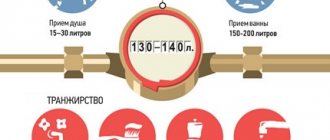Expert author of the article
Yulia Kuprina
Certified lawyer. Total work experience in the specialty is 13 years.
In most cases, installing metering devices on pipelines is beneficial. Current laws on water meters regulate the calculation procedure in the absence of water meters and in their presence. The amount to be paid in the first case may be significantly higher than when calculating by meters. In this article, we will look at the regulations in force in 2021, innovations, obligations of the apartment owner, sanctions and fines.
In the absence of IPU, the standard and increasing coefficient are applied in the calculations
According to Part 1 of Art. 157 of the RF Housing Code, clause 80 of RF PP No. 354, fees for utility services are calculated based on the readings of installed individual metering devices, and in the absence of meters - based on consumption standards approved by the constituent entity of the Russian Federation.
The owner of the premises must install the IPU (clause 81 of the Russian Federation Regulations No. 354). If the apartment has the technical ability to do this, but the owner of the apartment has not fulfilled this obligation, then the utility service provider applies an increasing factor of 1.5 to the standard when making calculations (paragraph 3 of clause 42 of RF PP No. 354).
If residential premises in an apartment building belonging to a municipal housing stock are rented out under a social tenancy agreement, then the municipality is obliged to fulfill the responsibilities assigned to it by the RF Housing Code as the owner, including equipping the apartments with private monitoring systems (Part 3 of Article 65 of the RF Housing Code). The social housing tenant, for his part, is obliged to pay for utilities and housing services on time and in full (clause 5, part 3, article 67 of the Housing Code of the Russian Federation).
It turns out that if the owner of municipal housing does not fulfill the obligation to install an IPU, then the tenant of such an apartment receives receipts with inflated amounts of payment for the utility resource and is obliged to pay it.
What you need to know about checking and replacing electricity meters
430391
If the foreman from the management company changes
If the owner wants the replacement to be made by a technician from the housing and communal services or management company, then a number of actions must be performed:
- Write a statement requesting that the meter be replaced.
- Purchase a device that complies with legal requirements.
- Agree on the timing of the technician’s arrival.
- The master makes a replacement.
- The technician seals the water meter and also signs the device’s passport and indicates the date of commissioning.
The act of replacing the device is made in two copies: one remains with the owner of the apartment, the other is given by the master to the management company. From the new month, readings are calculated according to the installed device. In order for the replacement to be carried out quickly and accurately by a technician, it is important to prepare access to the pipes in advance and also make sure that they are in good condition. Before work, the water must be turned off.
The municipality refused to pay for the consequences of failure to install IPU in apartments
One of the management organizations of St. Petersburg faced such a situation. The management authority, judging that the municipality was responsible for the failure to install meters, issued an invoice for 615 thousand rubles to the state housing agency, which is responsible for the municipal housing stock.
This amount was the difference between the cost of the volume of electricity, calculated on the basis of the standard using an increasing factor, and the cost of the resource, which was calculated only on the basis of the standard, and was offered for payment to tenants of social apartments.
The housing agency, as well as the municipality, refused to pay the bills, citing the fact that from the moment the social rent agreement is signed, tenants of residential premises are required to pay for utilities.
Self-replacement
Few people know, but you can replace the water meter on your own - this will require you to perform a number of procedures, but at the final stage you will still have to call a water utility inspector or a technician from the housing and communal services department for sealing.
Getting permission
Before obtaining permission to replace it yourself, you must purchase a hot or cold water meter. Its characteristics must match the flow of water in the pipes so that problems do not arise. According to the standards, the device must comply with SP 30.13330.2012, GOST P 50601‑93 - such data is usually clarified by the seller and is also written down in the technical passport for the product.
The passport must indicate the warranty period, as well as model certification - this is the only way the product can pass selection according to the law. To obtain permission, you should contact the management company and negotiate.
According to the rules, housing and communal services cannot refuse independent replacement, but there are organizations that are categorically against this action. This is due to filling the company’s budget, because the service is considered paid. As a result, the apartment owner must receive a certificate of permission to remove the seal, and then begin work.
List of documents for self-replacement
To avoid any questions from the management company, it is recommended to carefully prepare for obtaining permission. The organization will issue approval without any problems if you provide:
- technical passport of the water meter;
- a document confirming that the meter has been inspected by the relevant authorities.
As soon as the organization receives these documents, it will issue a permit, the apartment owner will have to independently dismantle the old device, install a new one, and also call a specialist for sealing.
Removing the old water meter
Before replacing water meters, it is necessary to shut off the riser with the appropriate type of water. When the valve is closed, you need to check whether there really is no pressure. Then open the valve on the mixer to release the pressure.
Note! When dismantling the old meter, the water that remains in it flows out. To avoid dirt, you should prepare rags and a basin in advance to drain the liquid.
To remove the meter yourself, you will need an adjustable wrench and a pipe wrench. Using an adjustable wrench, you need to unscrew all the nuts located on both sides of the product, and then clean the fitting from corrosion and old gaskets. To remove plaque, you can use a special cleaning liquid by applying a cloth soaked in it to the spare part for 30 minutes.
Additional fittings
One of the prerequisites for normal operation of the device is the presence of a check valve. It performs the following functions:
- increases the service life of the metering device;
- allows the water meter to be used correctly;
- ensures that there are no drops in water pressure in the apartment;
- allows you to avoid excessive consumption of hot and cold water, because the pressure at the inlet and outlet differs, therefore, water can mix, which will entail additional costs.
Another necessary element is a cleaning mesh filter, which will prevent contamination of the device with impurities from the water. If it is difficult to find one, then it is recommended to use old filters from pipes, having pre-treated them. These elements may come complete with metering devices, so when choosing, you should check with the seller. If the check valve is not included in the kit, you can purchase it at a plumbing store.
Installation of a new
Installing a new device is an equally responsible process. To do everything correctly, it is worth preparing the tools - a grinder, a hacksaw, a gas and adjustable wrench, FUM tape, angles, bends, transitions to another diameter - if necessary. In the store you need to purchase a water meter, a check valve and a strainer. The bends and corners can be replaced with flexible hoses.
Installation algorithm:
- Choosing a location. Often the easiest place to install a water meter is near the sink, bathtub or toilet. It is advisable to equip a special area for convenient viewing of readings.
- Pipeline insertion. If plastic pipes are installed, the easiest way is to cut them with special scissors and make the connection. Pipes made of polymer material will have to be connected using a soldering machine, but it is unlikely that you will be able to process metal ones yourself. You will have to call the experts and replace the riser with a more modern one.
- Assembly of the structure. To understand the order in which to connect the elements, it is recommended to lay them out on the floor.
First, the shut-off valve is screwed on, and it is important to remember the number of turns, and also use FUM tape or tow. Then a coarse filter and a counter are installed.
Important! When assembled, the faucet switch, filter sump and meter dial should face up, and the impeller should face down.
There are arrows on each design detail. They show in which direction the water will move, which will allow the meter to be installed correctly. If the arrows are mixed up during installation, the inspector will not seal it. Only those devices that are installed in accordance with all requirements may be allowed into operation.
In what cases is replacement required?
There are several situations when replacing a water meter is mandatory. To do this, you don’t always need to invite a technician from the management company, because signs of a malfunction will be visible to the naked eye. Some common problems are random stops of the device, as well as replacing the riser. Then the apartment owner must contact the housing and communal services department, reporting difficulties with operation.
Another nuance is the end of the service life of the device specified in the passport. It is recommended to take care of the replacement at least 1.5-2 months before the end of the prescribed period. There is no need to change the water meter 4-6 years after its installation. According to the law, it is enough to verify the product.
Commissioning
To put the meter into operation in apartments, it is worth visiting the management organization or housing and communal services. If a water meter is installed, but not registered and sealed, the resource will be calculated at the maximum - according to the number of registered people in the apartment. Within 3 days after submitting the application, an authorized master or water utility inspector will arrive.
He must present all documents for the product. The inspector is not obliged to check the brand of the meter and other nuances. He will also not make any claims to the qualifications of the master who carried out the replacement. Free subscribers are not welcome at the water utility, so the procedure will go quickly. The inspector will make entries in the commissioning report: meter number, readings and date.
Sealing and registration
After commissioning, the inspector seals the device. For this, special devices are used that wrap the entire water meter assembly. Next, the inspector issues a service agreement, which requires the signature of the apartment owner. You should carefully read the terms of the document.
To register a water meter, you must:
- Conclude an agreement with a service company - housing and communal services or water utility.
- Provide an acceptance certificate for the installation work done.
- Provide the commissioning certificate in 3 copies.
- Show passports for hot and cold water meters.
During the registration process, verification periods are determined, the year of manufacture of the devices, as well as serial numbers are recorded. The installation date and starting indicators are entered into the act. The owner of the apartment does not always need to go to the organization to carry out this procedure. All documents must be provided to the inspector, who will transfer them to the company.
The owner must ensure the installation of IPU in social housing stock
The management organization filed a lawsuit demanding to recover from the state institution, which represents the interests of the city administration as the owner of apartment buildings, the amount of debt (case No. A56-18735/2018).
The court of first instance sided with the management organization. Since the municipality is the owner of premises in an apartment building, it was they who had to ensure the installation of IPU in residential premises. The defendants were unable to provide documents confirming that this was technically impossible.
The management organization had the right to conduct calculations using an increasing factor, and it was the municipality that must pay the difference in charges with and without the application of an increasing factor.
The court decided that the state institution responsible for the social housing stock and representing the administration of St. Petersburg is obliged to pay the debt.
Who pays for the error when determining the meter's capacity?
88140
In the absence of IPU, the employer pays the standard, and the owner of social housing pays the increasing coefficient
The dispute between the management organization and the municipality regarding the payment of the increasing coefficient was put to rest by the Supreme Court of the Russian Federation, where the management company filed a complaint.
The RF Supreme Court analyzed the decisions of all previous courts and came to the following conclusions:
- The owners of the premises had to install IPU in them before January 1, 2011 (Part 4 of Article 13 No. 261-FZ, Clause 81 of the RF PP No. 354). This obligation is assigned to all owners of premises in an apartment building, regardless of whether it belongs to the state (municipal) or private housing stock and whether the owner uses this premises for living or rents out these premises.
- An increasing factor is used when calculating payments for utility resources for premises in which IPUs are not installed. An exception is the presence of an inspection report indicating the lack of technical ability to install a meter (clause 42 of the RF PP No. 354).
The housing agency against which the UO filed a claim is the representative of the owner of the disputed premises. The institution did not provide the court with evidence that there is no objective possibility of installing an IPU in the residential premises.
The Supreme Court of the Russian Federation agreed with the conclusions of the court of first instance that the consequences for failure to install meters cannot be laid on the tenants of residential premises: they are not obliged to equip apartments with metering devices and are not authorized to independently make decisions about this. Consequently, the management organization cannot, by virtue of law, impose on them the obligation to pay the increasing coefficient.
The Supreme Court of the Russian Federation overturned the decisions taken by the courts of appeal and cassation and ordered the housing agency to pay the amount of debt to the management organization in accordance with the decision of the court of first instance.
What the law says about checking and replacing meters
In accordance with Art. 13 Federal Law No. 102-FZ, all measuring instruments must be periodically verified during their use. To do this, each device is assigned its own verification period (interval). At the end of it, the water meter must either be verified or replaced with the same one with similar characteristics.
That is, further use of such a meter, as well as accounting for used water using it, is possible until the expiration of its calibration interval or its loss.
The verification date and frequency for each device are set by the manufacturer when carrying out certain tests. This information is indicated in the passport for the device.
When buying a water meter, it is important to pay attention to the date of initial verification. That is, if you buy a meter with an expiring date and install it, you will still have to recheck it or replace it soon.
Read details about the verification procedure.
The calibration interval for water meters is as follows:
- For cold water – 6 years.
- For hot water, this period is 4 years or 6 years (depending on the specific model).
This is due to the different chemical composition of water, which affects the wear of equipment.
The consumer must decide whether to change the meter or have it verified independently. According to statistics, only a small number of water meters undergo mandatory testing and, after the expiration of the verification interval, meet the stated requirements.
At the same time, the procedure for replacing a metering device in an apartment takes place in a shorter time and is accompanied by lower expenses.
Therefore, it is necessary to decide whether the meters need to be changed or examined based on the totality of all factors.
Remember
The management organization, as the provider of the utility service, has the right to apply an increasing factor in calculations in accordance with clause 42 of the RF PP No. 354 if:
- the premises are not equipped with an individual utility meter;
- there is no act confirming that it is technically impossible to install the IPU.
If the premises are part of the state or municipal housing stock, then the obligation to equip the premises with meters lies with the owner - a state or municipal authority.
Consequently, as noted by the Supreme Court of the Russian Federation, it is the public owner who must pay the difference between the cost of the resource, calculated using an increasing coefficient, and the amount accrued to the tenants of the premises based on the consumption standard. Residents of a municipal apartment should not bear financial responsibility for the failure of the owner of the housing stock to fulfill his duties.
Why structures fail
There are 6 reasons why the resource consumption calculation system may not work correctly:
- Interference with the system. Owners often try to find a way to bypass consumption metering. A striking example is magnets that block the operation of the mechanism. Prolonged exposure to such devices leads to the fact that the device begins to show incorrect data even after removing the magnets.
- Debris getting into the meter mechanisms. Debris and impurities can travel through water pipes, causing the large debris screen to become clogged over time.
- Depressurization. A sign of such a problem is foggy glass. To solve it, you will need to turn off the water supply and determine where exactly the breakdown lies (in the device itself or in the pipe). A common cause of this situation is a faulty shut-off valve.
- Incorrect installation. Most often, the reason occurs if the installation process was carried out by a person without special knowledge, for example, the owner of the apartment himself.
- Increased water temperature. The maximum temperature at which the device will function normally is 90 degrees. Anything higher will cause the system to crash.
Whether the water meter needs to be replaced is indicated by its serviceability. If the device works well, then it is not required, but if the calculated consumption is incorrect, then the help of a specialist is needed.







